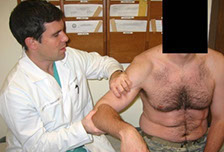re%20copy%20copy.jpg?crc=4256323138)


Call for appointment (401) 330-1434


Shoulder Instability
 Shoulder Instability comprises a broad spectrum of complaints from recurrent dislocations to intermittent subluxations (partial dislocations). Subluxations actually comprise 85% of instability and have been shown to result in labral tears (Bankart lesion). Young athletes with first-time shoulder instability injuries should consider surgical stabilization, and older patients with chronic instability that limits their lifestyle may also choose to undergo stabilization. Patients with bone loss may not be candidates for arthroscopic stabilization and may require open bone augmentation procedures.
Shoulder Instability comprises a broad spectrum of complaints from recurrent dislocations to intermittent subluxations (partial dislocations). Subluxations actually comprise 85% of instability and have been shown to result in labral tears (Bankart lesion). Young athletes with first-time shoulder instability injuries should consider surgical stabilization, and older patients with chronic instability that limits their lifestyle may also choose to undergo stabilization. Patients with bone loss may not be candidates for arthroscopic stabilization and may require open bone augmentation procedures.
RELATED STUDIES
SHOULDER SUBLUXATIONS COMPRISE 85% OF ALL TRAUMATIC SHOULDER INSTABILITY EVENTS
This prospective study of shoulder instability in the closed population of West Point cadets reports the highest known incidence rates in the world. Anterior events comprised 90%, and subluxations were 85% of all events.
SHOULDER SUBLUXATIONS RESULT IN BANKART LESIONS
This prospective study of first-time shoulder subluxation patients undergoing early MRI, showed that most had sustained a Bankart lesion – tearing of the anterioinferior glenoid labrum.
HISTORY IS BIGGEST PREDICTOR OF SUBSEQUENT SHOULDER INSTABILITY
Prospective 4 year study of high-risk young athletes showed that history of prior instability event was the greatest predictor of sustaining a shoulder dislocation or subluxation event.
ROTATOR CUFF WEAKNESS IS NOT A RISK FACTOR FOR ANTERIOR INSTABILITY
Prospective cohort study with baseline strength assessment clarifies issue of rotator cuff weakness seen in shoulder instability patients. The weakness may result from instability episodes but is not a risk factor for initial injury.
INCREASED GLENOID RETROVERSION IS RISK FACTOR FOR POSTERIOR INSTABILITY
Prospective cohort studies showed that for every 1 degree increase in glenoid retroversion, there was a 17% increased risk of posterior instability in young athletes.
PEDIATRIC SHOULDER DISLOCATIONS
Review article on pediatric shoulder dislocations presented pooled results from the literature. This work suggests that patients with open growth plates and are younger than 14 are often treated successfully without surgery. Patients older than 14 often experience recurrent instability and should be treated similarly to young adults.
YOUNG AGE ASSOCIATED WITH HIGHER FAILURE RATE OF INSTABILITY REPAIR
Retrospective review of 3,854 patients undergoing surgical stabilization. Younger age and open repair were associated with increased failure rate.
IN-SEASON SHOULDER INSTABILITY IN ATHLETES
Prospective multicenter cohort study followed collegiate collision athletes following a traumatic anterior shoulder instability event and found that only 27% returned to sport successfully without sustaining a recurrent event.
• SLAP Lesion/Biceps Tendinopathy
• Acromioclavicular (A-C) Sprain/Shoulder Separation

HOME
ABOUT
AREAS OF EXPERTISE
PATIENT RESOURCES
PRESS & PUBLICATIONS
OUR PATIENTS
CONTACT
Shoulder
Elbow
Knee
Leg/Ankle
Shoulder Instability
Rotator Cuff Tear
Subacromial Impingement
SLAP Lesion/Biceps Tendinopathy
Acromioclavicular (A-C) Sprain/
Shoulder Separation
Pectoralis Major Tendon Tear
Clavicle Fracture
Snapping Scapula Syndrome
Dr. Brett D. Owens
100 Butler Drive
Providence, RI 02906
Phone: 401-330-1434
Fax: 401-277-0799
DISCLAIMER
All information contained on the BrettOwensmd.com website is intended for informational and educational purposes. The information is not intended nor suited to be a replacement or substitute for professional medical treatment or for professional medical advice relative to a specific medical question or condition.
AFFILIATIONS LINKS